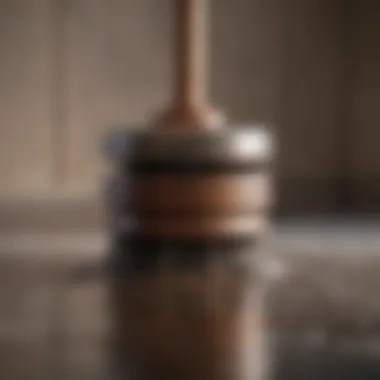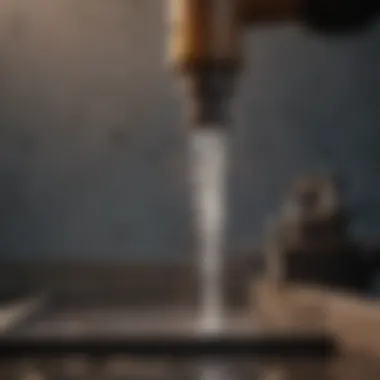Effective Solutions for Unclogging Drains


Intro
Understanding how to effectively unclog drains is a crucial skill for homeowners. Drain blockages can lead to a range of problems, including unpleasant odors, water damage, and even pest infestations. This article delves into various methods for tackling drain clogs, focusing on safety and efficiency.
There are numerous strategies available, from traditional techniques that homeowners have used for generations to modern innovations that offer convenience and speed. This guide will present both common and less conventional options, aiming to provide the necessary knowledge to handle drain issues adeptly.
In this article, readers will be equipped with insights regarding the efficacy of each method, safety precautions to consider, and the environmental implications of the chosen solutions. The ultimate goal is to enhance the homeowner’s ability to maintain their household efficiently and sustainably.
Traditional Methods of Unclogging Drains
Boiling Water
One of the simplest methods to clear blocked drains is using boiling water. It is particularly effective for minor clogs caused by grease or soap buildup. By pouring boiling water slowly down the drain, it can dissolve the clog and allow for smoother drainage. This method is safe and inexpensive but may not work for more severe blockages.
Baking Soda and Vinegar
This combination is well-known for its effectiveness in tackling mild clogs.
- Start by pouring half a cup of baking soda down the drain.
- Follow it with half a cup of vinegar.
- Allow the mixture to fizz and sit for about 30 minutes.
- Flush the drain with hot water.
This reaction can help break down debris and keep drains flowing freely.
Plunger
A plunger is a classic tool in plumbing. It can be used for toilets, sinks, and tubs. To use a plunger effectively:
- Ensure there's enough water in the fixture to cover the rubber part of the plunger.
- Place the plunger over the drain and push down firmly, then pull up quickly to create a vacuum effect.
- Repeat several times.
This mechanical action can clear blockages caused by foreign objects or buildup.
Modern Solutions
Drain Snake
A drain snake is a tool designed to reach deep into pipes. It can effectively remove stubborn clogs that traditional methods struggle with. To use it:
- Insert the snake into the drain until you encounter resistance.
- Crank the handle to break up the clog or hook onto the debris.
- Carefully pull it out, bringing the blockage with it.
It is an effective solution for tough obstructions and can save time and effort.
Enzyme Cleaners
These products use natural enzymes to digest organic material in drains. Unlike harsh chemicals, they are safe for pipes and the environment. To use an enzyme cleaner:
- Follow the product's instructions on the amount to pour down the drain.
- Allow it to sit for the recommended time, typically overnight.
- Flush the drain with water the next day to wash away the loosened debris.
Environmental Considerations
When opting for solutions to unclog drains, it is essential to consider their impact on the environment.
- Natural methods like baking soda and vinegar are preferable as they do not introduce harsh chemicals into the water system.
- Enzyme cleaners are designed to be eco-friendly while still being effective.
Remember that regular maintenance can prevent clogs from becoming severe. Simple habits can save you time and money.
Understanding Drain Clogs
Understanding drain clogs is an essential step in maintaining a functional plumbing system. Drain clogs can arise from various factors, and recognizing these can prevent small issues from becoming significant troubles. Awareness of the causes, signs, and consequences of clogs equips homeowners to take proactive measures.
A clogged drain can impact daily activities, causing inconvenience and frustration. Moreover, understanding drain clogs allows homeowners to make informed decisions about their plumbing maintenance and potential repairs. By grasping the basic mechanics of how drains work and why they clog, individuals can appreciate the complexity involved in effective unclogging solutions.
Common Causes of Clogs
Clogs can be attributed to a variety of common causes. Some of the most prevalent include:
- Hair: Accumulation of hair in bathroom drains is a significant culprit. Hair can snag on other debris, forming a dense blockage.
- Food Waste: In kitchen sinks, remnants of food can build up in the drain, leading to slow drainage or complete blockage.
- Grease: Cooking oil and grease can solidify within pipes, trapping other particles and obstructing the flow.
- Soap Residue: Soap can produce a sticky residue that eventually builds up over time, creating a barrier to water flow.


Each of these factors contributes in unique ways to the development of clogs. Recognizing these elements can enable homeowners to adjust their habits accordingly.
Signs of a Clogged Drain
Identifying a clogged drain early can save time and money. Some common signs include:
- Slow Drainage: Water pooling in sinks or tubs while draining is often the first indicator.
- Unpleasant Smells: Foul odors can arise from stagnant water and decomposing matter trapped in the pipes.
- Gurgling Sounds: If you hear gurgling noises in the drain, it can suggest air trapped due to blockage.
- Recurring Backups: Frequent backups are a clear sign that something is amiss in the drainage system.
Timely detection of these signs is crucial. Ignoring these indicators can lead to more severe plumbing issues that require costly repairs.
Implications of Ignoring Clogs
Neglecting drain clogs can have far-reaching consequences:
- Water Damage: Backed-up drains can lead to leaks and water damage in your home, affecting walls and flooring.
- Health Risks: Stagnant water can create a breeding ground for bacteria and mold, presenting health risks to occupants.
- Increased Costs: Waiting to address a clog often escalates repair costs, as minor issues can morph into major plumbing problems.
- Damage to Plumbing Systems: Severe clogs can cause pressure buildup in pipes, potentially leading to ruptures or complete pipe failure.
Ignoring the early signs of a clogged drain can compromise the integrity of a home’s plumbing system. Addressing them promptly not only safeguards against damage but also promotes a healthier living environment.
Traditional Methods
Traditional methods for unclogging drains are essential tools in maintaining household plumbing systems. These approaches are often the first line of defense against common drainage issues. They encompass a variety of techniques that can be utilized by homeowners without needing specialized skills or expensive equipment. The benefits of traditional methods are clear: they often require minimal investment and can produce immediate results without the need for chemicals that may harm the environment.
Plungers
Types of plungers
When considering plunger types, it is crucial to understand their specific functions. The most common types include the cup plunger and the flange (or toilet) plunger. The cup plunger is designed for sinks and tubs. It features a rubber cup at the end, which creates a seal to generate suction. On the other hand, the flange plunger has a protruding rubber flap that helps form a tighter seal in toilets. This distinction is vital because using the correct type contributes to successful unclogging.
Proper usage instructions
Proper usage of a plunger is significant to its effectiveness. Start by ensuring the area around the drain is clear. For sinks, fill the basin halfway with water, which aids in creating an effective seal. Then, place the plunger over the drain and push down firmly. Follow this by pulling up quickly, repeating the motion for several minutes. This technique generates pressure and suction, dislodging the clog. Correct application can often yield faster results than awaiting professional help.
Limitations
Despite their effectiveness, plungers have limitations. They may struggle with severe blockages or particularly stubborn clogs caused by solid objects. For these situations, reliance on a plunger might lead to frustration. Moreover, in some cases, improper use can push debris further down the drain, complicating the issue. Understanding these limitations helps a homeowner manage expectations.
Manual Snake Tools
Overview of snake tools
Manual snake tools, often referred to as drain augers, are another effective traditional method for unclogging drains. The snake tool consists of a flexible metal cable that can reach deep into pipes to remove blockages. This tool is particularly useful in cases where plungers fail, due to its extended reach and ability to catch or break apart clogs. Their simple design belies their effectiveness, making them a popular choice for many homeowners.
Techniques for effective use
To use a manual snake tool effectively, it is important to insert the cable into the drain correctly. Start by rotating the handle of the snake as you push the cable forward. This movement helps the snake maneuver through the pipe bends and reach obstructions. If resistance is met, twisting the snake might break the clog apart. This method can be time-consuming but often yields successful results with patience and technique.
Safety precautions
Safety should always be a priority when using snake tools. Wearing protective gloves is necessary to prevent injury from sharp edges or debris. Avoid excessive force when pushing the snake into the drain, as this could damage plumbing fixtures. Additionally, be cautious of what types of materials are removed from the pipe to ensure they do not lead to further blockages or plumbing issues.
Homemade Solutions
Baking soda and vinegar method
A widely recognized homemade solution for unclogging drains involves using baking soda and vinegar. When combined, these substances create a chemical reaction that can break down minor clogs without harmful chemicals. Begin by pouring half a cup of baking soda down the clogged drain, followed by half a cup of vinegar. This natural solution is favored for being eco-friendly and simple to execute. However, it may not be effective in severe blockages, making it more suitable for maintenance than for significant issues.
Salt and boiling water approach
The salt and boiling water approach is another effective method. By pouring a cup of salt down the drain followed by boiling water, the salt can help break down grease and grime. The combination can assist in clearing minor clogs caused by buildup over time. This technique highlights the advantage of using common household items to manage plumbing issues.
Limitations and effectiveness
While homemade solutions can be beneficial, they often have limitations in effectiveness. They work well on minor clogs but may be insufficient for serious blockages caused by foreign objects or more stubborn debris. Understanding these limitations allows homeowners to choose the right method based on the severity of their drainage issue.
Chemical Products for Unclogging


In the realm of drain care, chemical products hold a prominent place. Their efficiency and convenience make them attractive solutions for tackling stubborn clogs. This section explores various chemical options available for homeowners dealing with drainage issues. Understanding these products is crucial, not only for effective unclogging but also for making informed choices regarding safety and the environmental impact of these solutions.
Types of Chemicals Used
Enzymatic cleaners
Enzymatic cleaners operate on a biological basis, using natural enzymes to break down organic matter clogging the pipes. They excel in degrading substances like hair, grease, and food particles. Their key characteristic is that they target specific materials without causing harm to plumbing systems.
The popularity of enzymatic cleaners stems from their gentle action compared to harsher chemicals. They are beneficial for regular maintenance and preventive care, ensuring drains remain clear and functional. However, one unique feature is that they require time to work effectively. Users may find this approach slower compared to other methods. They are more suited for prevention than for immediate unclogging.
Caustic solutions
Caustic solutions, such as sodium hydroxide, aggressively dissolve clogs by raising the temperature of the water. They are effective for tough blockages and are often very fast-acting. Their strong alkaline nature can rapidly break down grease and other substances that commonly obstruct drains.
Despite their effectiveness, users must exercise caution. The dangerous nature of these chemicals can lead to pipe damage if used improperly. Prolonged exposure may damage both the plumbing and the surrounding environment. Thus, while they offer a swift resolution, the risks demand careful consideration and adherence to safety guidelines before usage.
Solvent-based options
Solvent-based products utilize organic solvents to disintegrate clogs caused by grease and oil. These options are particularly valuable for kitchen drains affected by heavy cooking residues. Their key characteristic is the ability to penetrate thick buildups effectively, often yielding quick results.
Nevertheless, solvent-based options require careful handling due to their volatile nature. They can pose safety hazards if inhaled or improperly mixed with other chemicals. Their unique feature is an immediate unclogging ability, which is useful in urgent situations. However, consistent usage may lead to corrosion of pipes, making them less ideal for long-term care.
Comparison of Chemical Products
Effectiveness metrics
Comparing the effectiveness metrics of various chemical products relies heavily on factors like composition, target materials, and time taken to show results. For instance, caustic solutions may boast faster results but can be harmful to pipes, unlike enzymatic cleaners, which take longer but are safer for regular use. Assessing these metrics provides critical insights to consumers who prioritize both effectiveness and safety.
Impact on plumbing systems
The impact on plumbing systems by different chemical products can vary significantly. Enzymatic cleaners typically pose minimal risk to plumbing, making them safe for routine applications. On the other hand, caustic solutions and solvent-based options can lead to long-term damage if not used judiciously. It’s important for homeowners to evaluate their choice against the backdrop of potential plumbing issues arising from aggressive chemicals.
Environmental considerations
Environmental considerations play a major roles in selecting chemical products. Many consumers today prefer eco-friendly solutions that are less harmful to the environment. Enzymatic cleaners often rank highest in this aspect due to their biodegradable nature. Conversely, caustic and solvent-based solutions may contribute to pollution and require careful disposal to mitigate environmental harm. Understanding these attributes can guide better purchasing decisions for those mindful of their ecological footprint.
Safety and Precautionary Measures
When using chemical products for unclogging drains, safety precautions cannot be overlooked. Personal protective equipment, like gloves and goggles, is recommended to safeguard against potential splashes. Additionally, it is crucial to read the product labels and guidelines thoroughly. Proper ventilation is necessary when using solvent-based or caustic solutions, as fumes can be harmful.
In summary, chemical options for unclogging drains offer varied benefits and considerations. Homeowners must weigh effectiveness against safety and environmental impacts to make the most informed decisions.
Advanced Techniques
In addressing drain issues, advanced techniques provide innovative solutions that go beyond traditional methods. These can be particularly valuable for complex clogs that are persistent or require specialized handling. Such techniques often utilize technology and advanced tools, offering a more comprehensive approach to unclogging drains. This section highlights two key advanced techniques: hydro jetting and video inspection. Both methods have distinct advantages and considerations that can enhance the efficacy of drain maintenance.
Hydro Jetting
Overview of hydro jetting
Hydro jetting is a process that involves using high-pressure water jets to clear clogs from pipes. This technique stands out due to its ability to not only remove blockages but also to clean the interior surfaces of pipes. Water is expelled at high pressure, allowing it to dislodge stubborn debris, grease, and other obstructions. The primary characteristic that makes hydro jetting a beneficial choice is its efficiency in restoring flow in severely clogged or dirty pipes.
Benefits and drawbacks
The benefits of hydro jetting include its effectiveness in handling tough clogs without the need for harsh chemicals. This technique is able to restore smooth flow due to its thorough cleaning capabilities. However, drawbacks exist, such as the need for professional equipment and potential for pipe damage if not performed correctly. It is essential to consider the condition of plumbing when opting for hydro jetting, as older or weakened pipes may not withstand such intense pressure.
Cost considerations
The cost of hydro jetting can vary significantly based on multiple factors, such as the diameter of the pipes and the severity of the blockage. Generally, hydro jetting is perceived as a worthwhile investment due to its long-lasting results. However, compared to simpler methods, it can be more expensive upfront. For those weighing the options, understanding the potential for fewer future clogs post-treatment may justify the expense.
Video Inspection
Utilizing camera technology
Video inspection employs cameras that are inserted into pipes to visually assess the condition of plumbing systems. This innovative technique allows professionals to identify blockages, cracks, or other issues with precision. A significant advantage of utilizing camera technology is that it eliminates the guesswork involved in diagnosing drain problems. By visualizing the interior, issues can be addressed accurately and effectively.


Identifying the root cause
By using video inspection, one can effectively identify the root cause of persistent drainage problems. This aspect is crucial, as solving the immediate blockage without understanding the underlying cause may lead to recurring issues. Video footage can reveal multiple issues, from tree root intrusion to buildup of materials that require targeted solutions. This enhances overall maintenance strategies and helps in planning future care.
Effect on remediation strategies
The information gathered through video inspection profoundly impacts subsequent remediation strategies. Understanding the specific nature of clogs allows homeowners to choose the most effective method of resolution. Moreover, insights from the inspection can lead to tailored maintenance routines that can prevent future problems. For instance, if roots are frequently entering the pipes, solutions can incorporate regular inspections or treatments aimed at invasive growth.
In summary, advanced techniques like hydro jetting and video inspection are pivotal for thorough and effective drain management. By investing in these methods, homeowners can tackle serious clogs with assurance while promoting long-term plumbing health.
Prevention Strategies
Prevention is a fundamental aspect of maintaining the efficiency of your drainage system. Implementing effective prevention strategies can eliminate or reduce the likelihood of clogs, which in turn preserves the plumbing's integrity and functionality. By adopting a proactive approach to drain maintenance, homeowners can avoid costly repairs and the inconvenience associated with plumbing issues.
Routine Maintenance Practices
Regular cleaning tips
Keeping drains clean is essential for preventing buildup. One effective method is to routinely pour hot water down drains weekly. This helps dissolve any minor grease or soap residue that may accumulate over time.
The key characteristic of regular cleaning is its simplicity and low cost. This method is extremely popular as it requires no special skills or equipment. Regular cleaning is beneficial since it addresses issues before they escalate into severe clogs. However, it may not effectively remove persistent obstructions caused by hair or foreign objects.
Scheduling inspections
Regular inspections can detect potential problems early. A professional plumber can examine the pipes and provide a detailed assessment of their condition.
The uniqueness of scheduling inspections lies in its preventive nature. It can reveal issues not visible to the naked eye, such as pipes that are degrading or misaligned. Scheduling inspections may cost money, but it saves homeowners from larger repair bills later on, making it a wise choice for long-term drain care.
Identifying weaknesses in plumbing
Understanding the weaknesses in your plumbing system can significantly reduce the chances of clogs. This involves recognizing areas where pipes may be narrow or have sharp bends, as they tend to trap debris.
Identifying weaknesses is essential because it encourages early intervention. Homeowners can adjust their habits, such as being cautious when disposing of items down the sink. While this approach may require some effort in observation, the benefit of avoiding serious plumbing issues makes it a worthy practice.
Educating Household Members
Educating everyone in the household about proper drainage habits is crucial. When all members understand how to maintain the drains, it creates a collective effort in prevention.
Proper disposal methods
It is vital to educate family members about the types of materials that should never go down the drain. Food scraps, grease, and certain personal hygiene products can lead to serious clog issues.
The emphasis on proper disposal methods is due to its role in protecting the plumbing from preventable damage. By addressing disposal habits, households can drastically reduce clogging incidents. However, adapting to these practices may take some time, and patience is required.
Understanding warning signs
Recognizing the early signs of drainage problems helps in mitigating severe clogs. Slow draining sinks or unusual noises can indicate developing issues.
The distinct advantage of understanding these warning signs is early detection. Homeowners can take immediate action before a simple issue escalates into something serious. On the downside, it requires vigilance from all family members, which can be challenging in busy households.
Encouraging maintenance habits
Promoting regular maintenance habits among all household members ensures that everyone contributes to drain care. Simple actions like not flushing inappropriate items or regularly checking the sinks can have a significant impact.
Encouraging maintenance habits is beneficial because it creates a shared responsibility. It fosters a culture where everyone is aware of their role in keeping the plumbing system functioning properly. However, instilling these habits may take consistent effort and encouragement from a leading family member.
Culmination and Recommendations
In summarizing the topic of drain unclogging, it is vital to grasp the significance of selecting the most effective solutions available. Properly addressing clogged drains is not only about immediate remediation but also involves understanding long-term strategies to maintain plumbing systems. This article circulates through the various methods and tools that can be employed, ranging from traditional techniques that have served homeowners for decades to innovative and advanced solutions that enhance efficiency and effectiveness.
Summarizing Effective Solutions
A variety of methods exist for unclogging drains, each with its advantages and considerations. Key options include:
- Traditional techniques such as plungers and manual snakes, which require little investment and provide reliable results.
- Chemical products, which can effectively dissolve blockages but may carry risks to both human health and plumbing systems.
- Advanced techniques like hydro jetting and video inspection, which are instrumental in addressing severe clogs while minimizing damage to pipes.
Each solution contains unique benefits and drawbacks. Understanding the specific context of your clog—its location, material, and severity—will guide you in choosing the most appropriate method. Implementing preventive measures, as discussed earlier, can also reduce the frequency of clogs, ultimately saving time and money.
"Home maintenance is a proactive approach that can alleviate most drain issues before they manifest."
Final Thoughts on Drain Care
Drain maintenance is an integral component of home upkeep. Regular inspections, combined with educational efforts regarding proper disposal methods, can go a long way in preventing clogs. For homeowners, the goal should be to cultivate awareness about signs that indicate potential plumbing issues early on. This can include, but should not be limited to:
- Unusual odors
- Slow drainage patterns
- Gurgling sounds in sinks or toilets
Lastly, reinforcing the importance of routine maintenance cannot be overstated. The proactive measures taken today will yield dividends in the long run, ensuring your plumbing systems remain in top condition. With the combined knowledge of effective solutions and preventive strategies, anyone can navigate the challenges of drain care with confidence.















